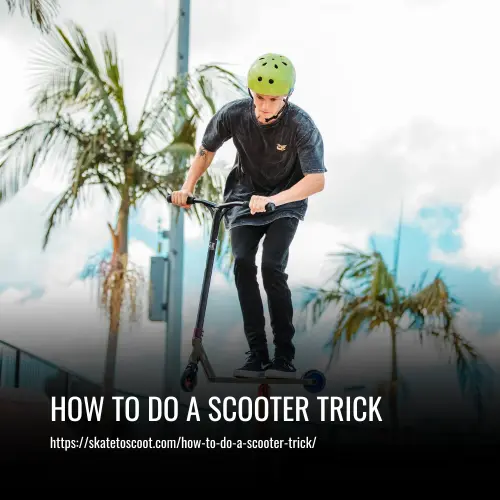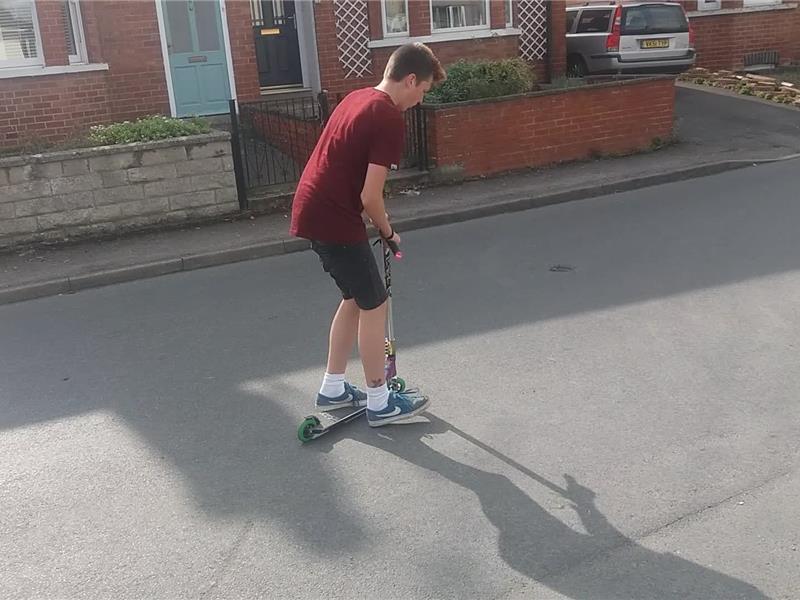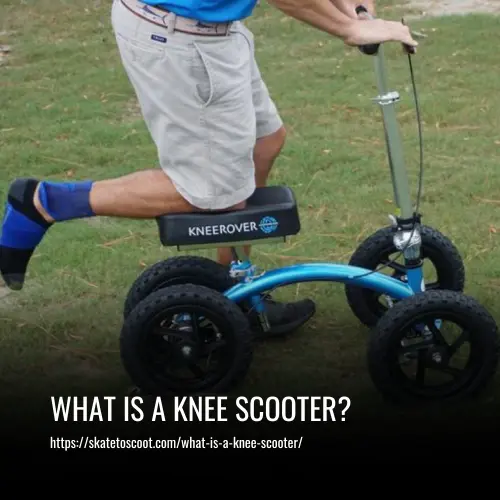As an Amazon Associate we earn from qualifying purchases.
Scooter tricks have become a popular way for riders to showcase their skills and creativity at skate parks and on the streets. Whether you are a beginner or an experienced rider, learning how to do a scooter trick can be a thrilling and rewarding experience. In this article, we will guide you through the steps to perform some basic and cool scooter tricks.
Before attempting any trick, it’s important to wear protective gear such as knee pads and a helmet, to ensure your safety. Additionally, having the right scooter deck and stunt scooters will provide you with the stability and control needed to execute tricks effortlessly.

How to Do a Scooter Trick: A Step-by-Step Guide
Scooter tricks are a thrilling way to showcase your skills and creativity at the skate park. Whether you’re a beginner or an experienced rider, learning and performing scooter tricks can add an extra element of excitement to your scooting experience. Here we’ll walk you through the steps to master some basic scooter tricks and introduce you to more advanced maneuvers.
1. Learning the Basic Jump
Start by mastering the basic jump. Unlike skateboarding or snowboarding, scooting provides the advantage of handlebars that help you pull the scooter up. Begin with a comfortable stance, placing your non-dominant foot at the front of the deck and your dominant foot at the back. Push off with your back foot to generate some speed, then crouch down and jump as high as you can, pulling the handlebars with you. Land smoothly by bending your knees and maintaining your balance.
2. Learning the Tailwhip
The tailwhip is a foundational trick to master. Position your feet on the deck, the front foot at the front and the back foot slightly behind. Gain some speed before crouching down and performing a jump. While airborne, use your back foot to kick the tail of the scooter in either direction. As the deck rotates away from you, help it return by moving the handlebars in a circular motion. Catch the deck with your feet when it comes back around and land smoothly.
3. Trying a Grind
Once you’re comfortable with jumping, you can progress to trying a grind. Find a rail at a skate park or a painted curb. Build some speed, then crouch down and jump slightly towards the rail, positioning yourself over it. Land on the rail with the bottom of your deck across it and maintain your balance. Use your foot placement and weight shifting to slide along the rail. When ready, jump off the rail and land with solid foot placement.
4. Getting Air
For a more exhilarating experience, incorporate getting air into your scooting routine. Ride up a ramp or a bowl at a skate park with enough speed. When you hit the coping, jump up and try some tricks in the air. Experiment with moves like “The X-Up,” where you twist the handlebars to form an “X,” or a barspin, where you spin the handlebars around. You can also try a tail grab, where you let go of the handlebars and grab the back of the deck with one hand.
Remember, practicing these scooter tricks requires patience, dedication, and ongoing improvements. Start with the basic jump and gradually advance to more complex tricks as you gain skills and confidence.
Scooter Tricks For Beginners
For those looking to venture into the world of scooter tricks, starting with basic tricks is essential. Here are some beginner-friendly tricks to get you started on your journey to becoming a skilled rider.
1. Bunny Hop
The Bunny Hop is a fundamental trick that will help you feel more comfortable being airborne on your scooter. Keep both feet on the scooter deck and hands on the handlebars, then jump. It may take a bit of practice to achieve height, but with time, you’ll be soaring higher. The best trick scooters have specialized tires that aid in the bounce. Once you’ve mastered the Bunny Hop on a flat surface, try jumping off low curbs or up a shallow step.
2. Nollie
Similar to the Bunny Hop, the Nollie uses only the front wheel. Lean and push forward slightly with your arms to lift the back wheel off the ground. While rolling on the front wheel, hop by lifting it off the ground. Start with one Nollie and gradually build up as you become more comfortable.
3. No Footer
The No Footer is a simple trick in which you take both feet off the deck and stretch them out while in mid-air. First, jump to a comfortable height while keeping your balance by holding the handlebars. For a smoother landing, watch the deck as you bring your feet back down. Start by jumping low and gradually increase height as your confidence grows.
4. One Hander
A One Hander is a great practice trick to prepare for more advanced moves. Jump to a comfortable height and take one hand off the rubber grips, stretching it out to the side. Maintain a firm grip with your other hand and as you come down, put both hands back on the handlebars to land. Start with a flat surface and progress to a quarter pipe when you’re ready.
5. Barspin
Once you’ve mastered no feet and one hand tricks, it’s time to work up to the handlebar spin. Start by practicing on the ground or with the front wheel off the curb. The trick is to spin the handlebars around for a full rotation without letting go completely. Let go of the bars at a quarter of the way around and be ready to catch them when they reach three-quarters. Jumping higher on your scooter will give you more time to spin. Begin on solid ground before attempting this move in the air.
Remember, learning scooter tricks takes time and practice, so start at a comfortable pace and always wear proper safety gear, such as knee pads and a helmet.

How To Do Scooter Tricks On Flat Ground
If you’re new to scooters and want to add some excitement to your riding experience, learning tricks on flat ground is a great place to start. Here are some tips to help you get started:
1. Balance is Key
Maintaining balance while moving is crucial when performing scooter tricks. Make sure to keep your center of gravity low and avoid leaning too far forward or backward. This will help you stay stable and in control of your scooter.
2. Control Your Direction
To steer your scooter, use your toes to control the direction you want to go. Push off the ground with your toes and use your body weight to steer the scooter in the desired direction. This will give you better control and make it easier to execute tricks.
3. Be Aware of Your Surroundings
Always keep an eye on the traffic and other pedestrians around you when performing tricks. It’s important to maintain a safe distance and avoid getting too close to other vehicles or obstacles. If something looks dangerous or you feel unsafe, stop quickly and prioritize your safety.
4. Start with Simple Tricks
For beginners, it’s best to start with simple tricks that you can comfortably perform on flat ground. Tricks like the Bunny Hop, Nollie, No Footer, and One Hander are great choices. Practice these tricks at a comfortable pace and gradually build your skills and confidence.
Remember, performing scooter tricks requires practice, patience, and attention to safety.
Choosing the Right Scooter for Tricks
When it comes to doing scooter tricks, having the right scooter is essential. A high-quality stunt or trick scooter is built to withstand the jumps, landings, and grinds that come with performing tricks. Here are some important factors to consider when choosing the right scooter for tricks.
1. Quality and Construction
Opt for a scooter made by a reputable manufacturer. Razor is a popular brand, but keep in mind that many of their scooters are designed for simple riding. Look for trick scooters with better quality materials and construction that can handle the stress of trick riding.
2. Steel Deck
Ensure that the scooter’s deck is made of steel. While low-end scooters often feature aluminum or wood decks, these may not hold up well during intense tricks. A steel deck may be heavier, but it provides increased durability and stability.
3. Online Reviews
Check online reviews to get insights into scooter quality and durability. Look for models that consistently receive positive reviews in terms of build quality and longevity. Be cautious of scooters that have complaints of breaking or falling apart easily.
4. Size and Handlebars
When selecting a scooter, consider the size that suits you best. Try out different scooters in-store or measure yourself if purchasing online. The handlebars should ideally reach your waist when you stand on the deck. Opt for fixed handlebars instead of adjustable ones, as they offer more stability during high-impact landings.
5. Wheel Size
Choose the right wheel size for your trick scooter. Scooter wheels come in various sizes, ranging from 98mm to 200mm. While larger wheels are suitable for cruising, professional stunt scooter riders prefer 110mm wheels. These wheels offer speed, longevity, and better brake control.
By selecting the right scooter for tricks, you’ll have a reliable and durable ride that can withstand the demands of intense trick riding.
Some Common Scooter Tricks
Scooter riding is not just about cruising around but also about performing impressive tricks that leave everyone in awe. Whether you’re a beginner or an experienced rider, there are a variety of scooter tricks you can learn to showcase your skills at the skate park. Here are some of the most common and coolest scooter tricks you can master with a bit of practice:
1. The Tail Grab: Start by heading uphill at a fast speed, then jump and lean back slightly. Let go of the handlebar with one hand and grab the back of the deck for a second. The longer you hold on and the better your grip, the more impressive the trick will be.
2. The Tail Whip: Jump as high as you can, kick the deck with the back of your foot to make it spin 360 degrees mid-air. When the deck comes back underneath you, hop on and ride along gently. Start with small hops called the “bunny hop” for beginners.
3. The 180: Hop high, keeping your back wheel elevated. Spin yourself around 180 degrees using your shoulders and head, with the help of the handlebar. Once you’ve mastered the 180, you can move on to the 360.
4. The Manual or Wheelie: Ride uphill, slide back on the scooter as far as possible, and pull on the handlebars while leaning back. Give a mild throttle to lift the front wheel off the ground. Gently lean forward to end the wheelie and land smoothly.
5. The Bunny Hop: Ride at a comfortable pace, jump with both feet and lift the handlebars in the air. Bend your knees when landing to absorb the impact.
6. The Air Trick: Gain speed and as you approach the edge of a half-pipe, pull your front wheel off the coping, spin 180 degrees in the air, and land under the coping smoothly.
7. The Heel Whip: Similar to the tail whip trick, use your heels to whip the deck in the opposite direction. Catch the spinning deck with your feet.
8. The Bar Spin: Jump as high as possible, start spinning the handlebars around with one hand, let go and catch them back with a firm grip for a safe landing.
9. The Fakie: Roll backward down a quarter pipe, maintaining balance, and then cab out by spinning your scooter around and landing on it with your feet.
10. The One-Hander: Jump high, take one hand off the handlebar and stretch it out. Grab the handlebar back before landing.
11. The No Footer: Jump a comfortable height, take both feet off the deck, stretch them out, and bring them back to the deck while maintaining balance.
12. The Nose Pivot: Shift your weight onto the front wheel, spin 180 degrees, and smoothly return to the original position.
13. The Nollie: Lift the back wheel by leaning forward slightly while pushing forward with your arms. Bunny hop to lift the front wheel off the ground, and level yourself out for a balanced landing.
14. The Half Cab: Turn the handlebars slightly opposite the direction you want to spin while riding in a fakie. Turn yourself around by bunny hopping and throwing in your body weight.
15. The Double Tail Whip: Similar to the tail whip, but instead of one spin, perform two spins of the deck mid-air. Move the handlebars in a circular motion and hop onto the deck when it comes back underneath you.
With these common scooter tricks, you can impress your fellow park riders and elevate your scooter riding skills. Always remember to wear knee pads and practice at a comfortable pace that suits your skill level.
FAQs
Yes, it is possible to do tricks on a normal scooter. However, it’s important to ensure that the scooter is sturdy enough and has the necessary components to withstand the impact of trick riding. Upgrading to a stunt scooter with reinforced parts is ideal for performing more advanced tricks.
The time it takes to learn a scooter trick varies depending on the individual’s dedication, skill level, and the complexity of the trick. Simple tricks can be learned within a few days or weeks with regular practice, while more advanced tricks may take several months or even years to master.
For beginners, it’s recommended to start with basic tricks like the tail grab, bunny hop, or 180. These tricks are relatively easier to learn and provide a foundation for advancing to more complex tricks. It’s important to start at a comfortable pace, practice proper technique, and gradually increase speed and difficulty as skills improve.
The easiest trick for beginners is usually the bunny hop. It involves riding at a comfortable pace, jumping with both feet and lifting the scooter’s handlebars in the air. With some practice, riders can quickly master this simple trick.
Performing scooter stunts can be safe if proper precautions, such as wearing protective gear, are taken and if the rider has developed the necessary skills and control. It is important to start with beginner-level tricks and progress at a comfortable pace while always prioritizing safety.
Safety should always be a priority, especially when performing scooter tricks. It is highly recommended to wear protective gear such as knee pads, elbow pads, and a helmet to prevent injuries. Properly fitted gear can help cushion impacts and minimize the risk of serious harm while practicing or performing tricks.
The hardest trick on a scooter is subjective and varies depending on the rider’s skill level. However, some advanced tricks like the scooter flip, double tail whip, and bar spin can be quite challenging for most riders.
If you find yourself lacking sufficient airtime to complete a tailwhip, focus on increasing your jump height and speed. Maintain a smooth motion with your body weight centered and use your legs to generate more power when pushing off the ground. Gradually build up your strength and technique to improve your airtime for the trick.
To perform a tailwhip more quickly, focus on your body positioning and technique. Bend your knees and generate power by pushing off the ground with force. Use a quick circular motion with your foot to whip the deck around, keeping your upper body stable and balanced. Practice the motion repeatedly to develop speed and accuracy.
Conclusion
In conclusion, learning to do scooter tricks requires dedication, practice, and a commitment to safety. While some tricks may be more challenging than others, riders can start with basic tricks like the bunny hop or tail grab and gradually progress to more advanced maneuvers like the tailwhip or bar spin. It is important to start at a comfortable pace, master the foundational skills, and gradually increase difficulty and speed as confidence and skill level improve.
Wearing protective gear such as knee pads, elbow pads, and a helmet is crucial to prevent injuries while practicing or performing tricks. Safety should always be a top priority, and riders should never attempt tricks beyond their skill level or without proper supervision.
Amazon and the Amazon logo are trademarks of Amazon.com, Inc, or its affiliates.



